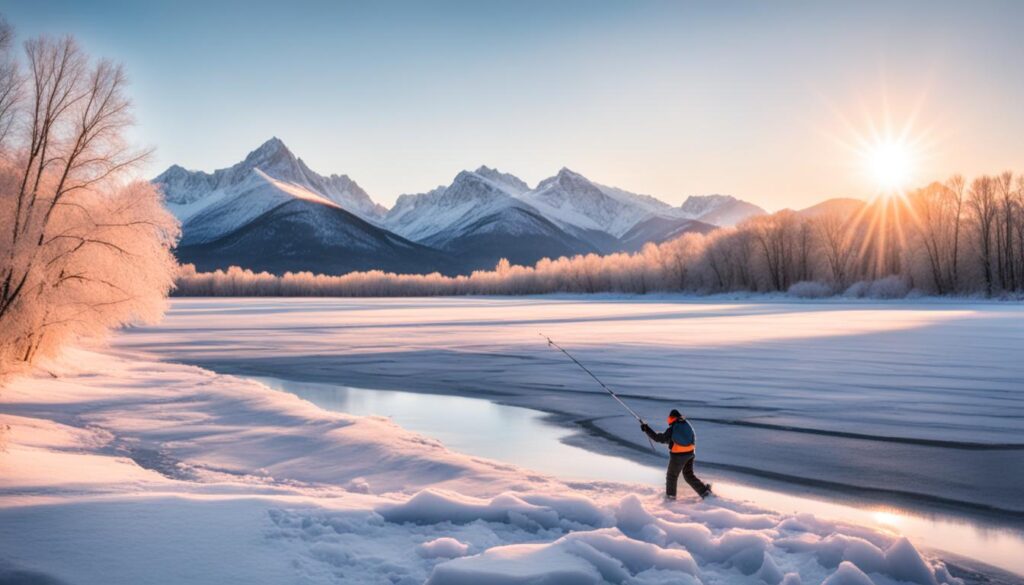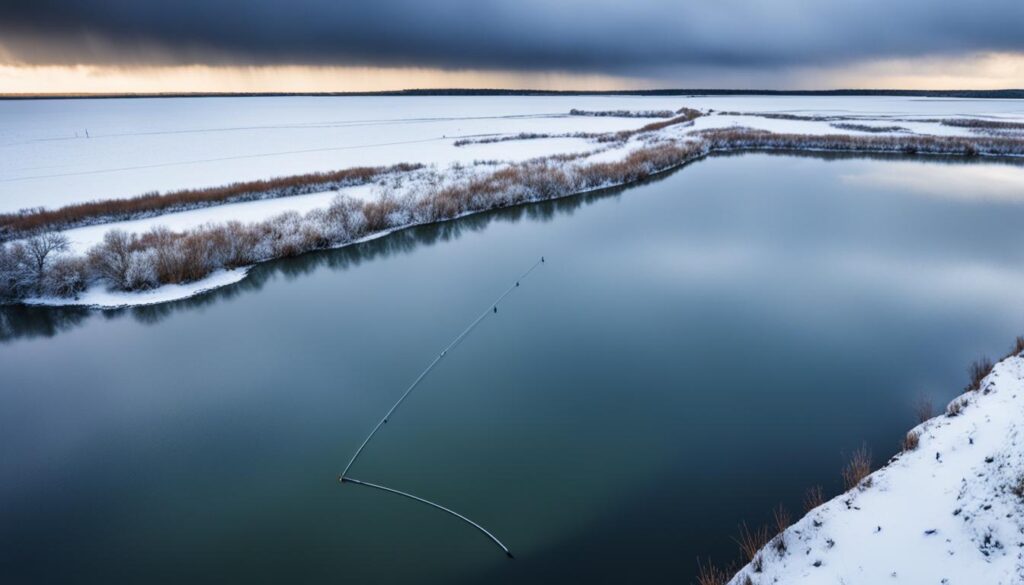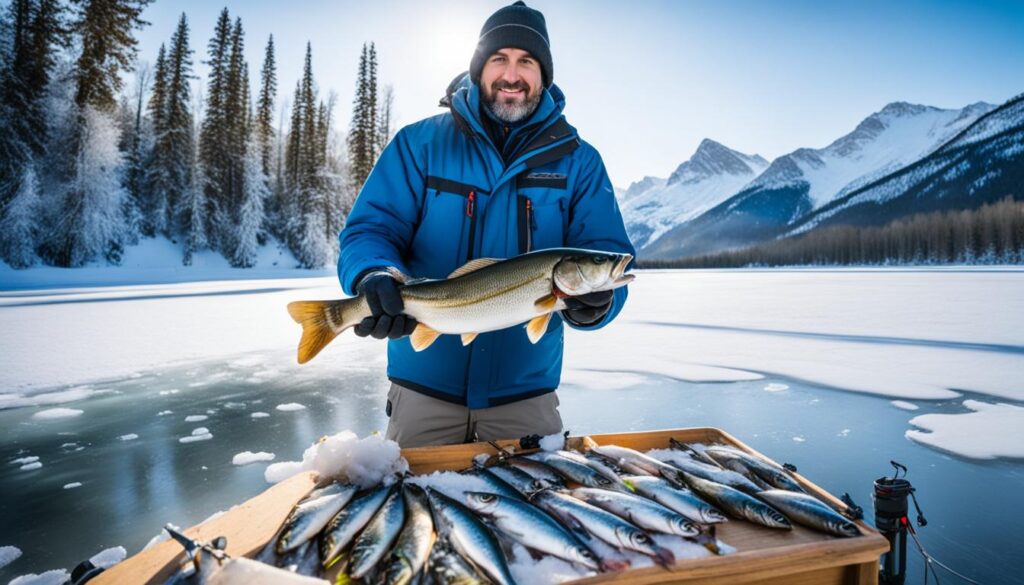Many anglers overlook the effectiveness of shallow-water fishing when it comes to winter bassWhen it comes to winter bass fishing, many anglers overlook the effectiveness of shallow-water fishing. While conventional wisdom suggests fishing deep water in cold temperatures, there are proven bass fishing tactics for extreme cold that target shallow areas with warm water. By focusing on warmer water, particularly in sunny conditions, and using power fishing techniques with reaction baits, anglers can increase their chances of success in winter fishing.
Key Takeaways:
- Warmer water in shallow areas can attract active bass during winter fishing.
- Targeting shallow water close to deep water can maximize your chances of catching bass in extreme cold.
- Power fishing techniques with reaction baits are effective for enticing bites from sluggish winter bass.
- Soft plastics and jigs can serve as fallback options if the shallow bite isn’t producing results.
- Adapting to changing weather conditions and targeting hotspots like gravel and clay banks can also improve winter bass fishing success.
The Importance of Warmer Water for Winter Bass Fishing
Water temperature is crucial in the bass’ winter activity level and feeding habits. When the water gets cold, bass metabolism slows down, reducing feeding activity. However, there are significant benefits to fishing in shallow water during cold weather.
In sunny conditions, shallow water tends to warm up faster, creating a welcoming environment for bass and other prey species. This increased warmth in shallow areas increases bass metabolism, making them more likely to feed actively. By targeting the warmest water available in a fishery, anglers can significantly improve their chances of catching more giant bass during extreme winter cold.
Understanding the importance of warmer water in winter bass fishing is critical to maximizing success in cold weather conditions. By focusing on shallow areas exposed to sunlight, anglers can enhance their chances of enticing bites from active bass.
| Benefits |
|---|
| 1. Warmer water attracts bass and prey species |
| 2. Increased warmth in shallow areas sparks bass metabolism |
| 3. Active bass are more likely to actively feed |
| 4. Targeting warmer water increases chances of catching bigger bass |
Targeting Shallow Water Close to Deep Water
In winter, bass prefer vertical movement within the water column, favoring shallow areas near deeper waters. Leading lake banks, channel swings, and primary points are prime spots for winter bass fishing due to their proximity to shallow feeding areas and secure deeper water. Anglers can capitalize on bass movement patterns by targeting these transitional zones, increasing their chances of success in extreme cold.
Understanding the significance of these transitional zones is crucial. Bass utilizes them as pathways between wintering and feeding areas, offering a balance of comfort and accessibility. Additionally, the temperature balance between deep and shallow water affects bass behavior, prompting them to move slightly deeper to find optimal temperatures.
Identifying shallow-to-deep water transitions is vital. Look for noticeable depth changes, such as points, underwater ledges, or submerged structures, which attract baitfish and, in turn, bass. Submerged vegetation can also provide additional cover and feeding opportunities.
Thoroughly covering the area and varying lure presentations are essential strategies. Bass may be at different depths within the transitional zone, so diversifying techniques increases the chances of enticing a bite.
In summary, targeting shallow water near deep water enhances winter bass fishing success. This approach allows anglers to intercept bass as they move vertically within the water column, presenting opportunities for effective lure presentations at various depths.
Using Power Fishing with Reaction Baits in Winter
Power fishing techniques with reaction baits can be highly effective in winter bass fishing. Instead of relying on slow-moving soft plastics, anglers can start with reaction baits to eliminate dead water and induce reaction strikes from otherwise inactive bass. Shallow-running crankbaits and bladed swim jigs are particularly effective in colder water temperatures. It’s essential to adjust the retrieve speed and slow down the presentation to cater to the sluggish behavior of winter bass.
Power fishing can be a game-changer when it comes to winter bass fishing. While traditional finesse techniques can work in certain situations, power fishing allows anglers to cover more water and trigger aggressive strikes even in extreme cold. By incorporating reaction baits into their arsenal, anglers can mimic the fast-moving prey that bass target during a winter-feeding frenzy.
One effective option for power fishing in winter is using shallow-running crankbaits. These lures imitate injured baitfish or crayfish, triggering a predatory instinct in the bass. The key is to choose a crankbait that runs at the appropriate depth for the water conditions. In colder water, bass stays closer to the bottom, so selecting a crankbait that dives no deeper than 5 to 10 feet is ideal.

Utilizing Soft Plastics and Jigs as Fallback Options
If the shallow bite with reaction baits isn’t producing the desired results in winter bass fishing, anglers can turn to soft plastics and jigs as effective fallback options. While conventional wisdom suggests using small, natural-looking soft plastics in winter, specific techniques can increase the chances of catching bigger bass in extreme cold.
Increasing your soft plastics’ size and fall rate is one tactic to consider. You can entice those more giant, less active winter bass to strike by presenting a larger bait with a slower descent. Experiment with different sizes and colors to find what works best in your specific fishing location
Another effective option is to incorporate jigs into your winter bass fishing arsenal. When paired with a heavy jighead or a Texas rig, jigs allow anglers to stay in shallow water while presenting a slow, enticing presentation. The subtle motion and realistic appearance of jigs can trigger bites from bass that may be hesitant to strike more aggressive reaction baits.
Maintaining patience and persistence when utilizing soft plastics and jigs is important. Winter bass fishing can be demanding, but adjusting your strategies, adapting to the conditions, and focusing on these fallback options increases your chances of success in extreme cold.
Adapting to Changing Weather Conditions

Adapting to changing weather conditions is crucial for maximizing your chances of success in winter bass fishing. Weather patterns, especially sunlight, significantly impact winter bass’ behavior and feeding patterns. Understanding these patterns and making adjustments can dramatically improve your fishing experience.
On sunny days, shallow water warms up quickly, creating a favorable environment for bass. The warmth attracts bass, and triggers increased feeding activity. Therefore, targeting shallow areas when the sun is out is essential, as bass are more likely to be actively feeding there.
However, bass tends to slide into deeper water when fishing in cloudy conditions. The lack of sunlight reduces the warming effect in shallow areas, causing bass to seek more profound, stable water. I’d like you to please adjust your techniques and focus on fishing deeper areas when the weather is cloudy.
Experimentation is key when adapting to changing weather conditions. By trying different techniques, locations, and bait presentations, you can find what works best for the specific weather patterns you encounter. Please pay attention to how the bass are responding and make the necessary adjustments.
Remember, adapting to weather changes in winter bass fishing requires patience and a willingness to try new approaches. By staying flexible and adapting your strategies to the prevailing weather conditions, you can increase your chances of success on the water.
Targeting Hotspots: Gravel and Clay Banks
Identifying critical hotspots in winter is crucial for booming bass fishing. These hotspots, gravel, and clay banks, are essential locations for every angler. These areas possess unique properties that make them ideal for winter bass fishing.
As temperatures drop, bass gravitate towards warmer areas conducive to feeding. Gravel and clay banks, due to their conductivity and heat retention, quickly warm under the winter sun. This warmth creates a comfortable environment for bass and attracts their prey species.
Why Are Gravel and Clay Banks Hotspots?
The conductivity and heat retention properties of gravel and clay banks create an inviting environment for bass. As the sun warms the water around these banks, bass become more active and start actively feeding.
Fishing Strategies for Gravel and Clay Banks
When targeting hotspots like gravel and clay banks, adapt your fishing techniques accordingly:
- Choose the Right Baits: Opt for lures mimicking the bass’ preferred winter prey, such as crawfish or shad. Spinnerbaits, jigs, and soft plastics in natural colors are ideal.
- Focus on Precision: Cast your bait parallel to the bank to imitate a natural presentation and increase strike chances.
- Vary Your Retrieve: Start with a slow and steady retrieve, but experiment with pace changes or occasional pauses to trigger bass reactions.
Not all gravel and clay banks have equal fish-holding potential. Identify productive areas by focusing on current seams, pockets, or irregularities along the bank. These nuances within the hotspot can often yield better results.
By targeting hotspots like gravel and clay banks, anglers improve their chances of winter bass success. Adapt strategies based on water temperature and remain patient and persistent for rewarding results.
“The gravel and clay banks serve as a virtual buffet for feeding opportunities during winter. Bass are drawn to these areas due to food availability and warmer temperatures,” says seasoned angler Mark Johnson.

Making Repeated Casts for Winter Bass Fishing Success
In winter bass fishing, patience and persistence are non-negotiable. As temperatures drop, bass seek refuge in dense, shallow cover like laydowns, docks, or stumps. To coax bites from these sluggish bass, anglers must repeatedly target specific cover spots. Yet, it’s crucial to understand that bass might not strike on the first try.
Anglers heighten their chances of triggering a reaction strike by persistently casting and agitating the bass. This demands unwavering patience, especially when bites are scarce. Winter bass often require extra enticing and agitation before committing to a strike.
“Patience is a virtue when it comes to winter bass fishing. It’s not always about the first cast; it’s about making the bass react. Keep making those casts, and don’t give up.”
Tips for Effective Repeated Casting:
- Target Specific Cover: Pinpoint potential bass-holding cover, such as laydowns, docks, or stumps.
- Vary Presentation: Experiment with different retrieval speeds and techniques to elicit a response.
- Focus on Precision: Deliver accurate casts to the target area, ensuring your bait lands near or on the cover.
- Utilize Different Baits: If one bait fails, switch to another to offer a fresh presentation and provoke a reaction.
Winter bass fishing demands persistence and adaptability. By persistently casting to a specific cover and exercising patience, you enhance your chances of hooking those sluggish winter bass.
Optimizing Retrieve Speed and Bait Selection for Winter Bass Fishing
Adjusting retrieve speed and bait selection becomes paramount as water temperatures plummet during winter bass fishing. A slower presentation is essential for enticing bites, with bass growing less active in colder waters. By grasping bass preferences concerning retrieve speed and bait choice, anglers can significantly boost their winter fishing success.
Slowing Down for Success
In cold water, slowing down the presentation is a must. This tactic extends the bait’s presence in the strike zone, heightening the likelihood of a bass taking notice and striking. Grubs, jigs, and spinnerbaits emerge as top picks in cold water due to their alluring action and adaptability. Tailoring the bait selection to specific conditions and fisheries is vital, necessitating experimentation to pinpoint the optimal choice.
Fine-Tuning Techniques
Take jigs, for instance. Anglers can manipulate retrieve speed by adjusting the jig’s depth and reeling pace. Gradually slowing down the retrieve and allowing the jig to descend leisurely mimics natural prey behavior, making it irresistible to bass. Conversely, spinnerbaits can be retrieved at a moderate speed, generating vibrations and flashes that beckon bass in cold waters.
Key Points to Remember
- Retrieve Adjustment: Align retrieve speed with bass lethargy in cold water.
- Preferred Baits: Grubs, jigs, and spinnerbaits excel in cold-water bass fishing.
- Experimentation: Tailor retrieves speed and bait selection to specific conditions through trial and error.
By adapting to chilly water temperatures and customizing retrieve speed and bait selection, anglers successfully elevate their prospects of landing winter bass.
Recommended Bait Selection for Cold Water Bass Fishing
| Bait Type | Description | Retrieve Speed |
|---|---|---|
| Grubs | Soft plastic baits with a grub-like shape and tail action. | Slow, subtle movements, allowing the bait to fall enticingly. |
| Jigs | Lure consisting of a weighted head and a skirted hook. | Varied depending on depth and desired presentation, typically slow with occasional pauses. |
| Spinnerbaits | Lure with one or more spinning metal blades and a skirted hook. | Moderate speed, creating vibrations and flashes to attract bass. |
Conclusion
Winter bass fishing presents challenges but also holds immense rewards for adaptable anglers braving extreme cold conditions. Anglers can significantly enhance their winter bass-catching prospects by targeting warmer water, employing power fishing techniques with reaction baits, and adjusting to fluctuating weather.
Patience, persistence, and adaptability are paramount in conquering winter bass fishing. Recognizing shifts in bass behavior amidst cold waters necessitates corresponding alterations in approach. Through unwavering focus and experimentation with diverse tactics, anglers can tap into the full potential of winter bass fishing.
While winter angling demands heightened effort and patience, the outcomes are often gratifying. With adept tactics and strategic maneuvers, anglers can transform even the chilliest days into bountiful fishing adventures. So, don your warm gear, equip yourself, and embark on the exhilarating journey of winter bass fishing!
FAQ
Can I catch bass during extreme winter cold?
Yes, it is possible to catch bass during extreme winter cold by employing proven tactics and strategies.
What are some effective winter bass fishing techniques?
Some effective winter bass fishing techniques include targeting warmer water, utilizing power fishing techniques with reaction baits, and adjusting to changing weather conditions.
Should I fish in shallow water or deep water for winter bass fishing?
While conventional wisdom suggests fishing deep water in cold temperatures, targeting shallow areas with warm water can be highly effective for winter bass fishing.
What types of baits are best for winter bass fishing?
For winter bass fishing, power fishing techniques with reaction baits such as shallow-running crankbaits and bladed swim jigs can be highly effective. Soft plastics and jigs can be used as fallback options if the shallow bite isn’t producing results.
How do weather conditions affect winter bass fishing?
Weather conditions, particularly the presence of sunlight, can significantly influence winter bass’ behavior and feeding patterns. Bass tend to be more active and feed more in shallow water that warms up quickly on sunny days.
What are some hotspots for winter bass fishing?
Bottom compositions such as gravel and clay banks that conduct and hold heat become hotspots for bass in winter. These areas warm up quickly and attract bass and their prey species.
How important are patience and persistence in winter bass fishing?
In winter bass fishing, patience and persistence are crucial. Making repeated casts to specific covers and aggravating the bass can increase the chances of triggering a reaction strike.
Should I adjust my retrieve speed and bait selection in cold water?
it is important to adjust the retrieve speed and bait selection for winter bass fishing. Slowing down the presentation and using baits such as grubs, jigs, and spinnerbaits can be effective in colder water.
